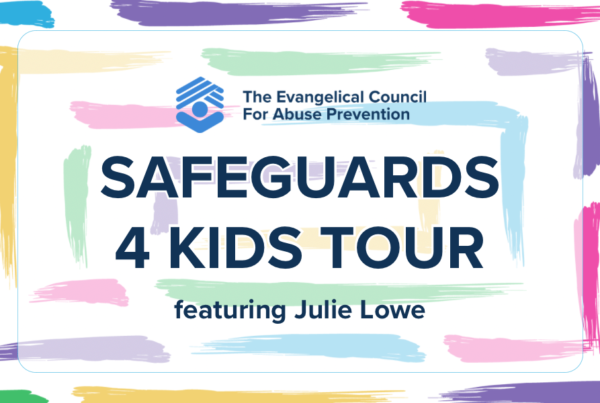April is National Child Abuse Prevention month. The purpose of this month is to recognize “the importance of families and communities working together to strengthen families to prevent child abuse and neglect. Through this collaboration, prevention services and supports help protect children and produce thriving families.”[1]
Why should your ministry devote time and resources to child abuse prevention?
- Each human being is made in the image of God, and is worthy of dignity and respect.
Christians must recognize the value of each life, regardless of age, ethnicity, socioeconomic status, or even religion. It’s good for ministry leaders to remind their staff, volunteers, and others under their influence to be on the lookout for signs of abuse and neglect, and to promote love and care for the most vulnerable in society: children. Jesus said, “Whoever receives one such child in my name receives me, 6but whoever causes one of these little ones who believe in me to sin, it would be better for him to have a great millstone fastened around his neck and to be drowned in the depth of the sea” (Matthew 18:5-6 ESV). The Old Testament prophet Zechariah announced, “Thus says the Lord of hosts, ‘Render true judgments, show kindness and mercy to one another, 10do not oppress the widow, the fatherless, the sojourner, or the poor, and let none of you devise evil against another in your heart’” (Zechariah 7:9-10 ESV).
- Abuse can happen in ministries.
According to Child Protect, a children’s advocacy center, “3.6 million cases of child abuse are reported every year in the U.S.”, “1 out of 3 girls and 1 out of 5 boys will be sexually abused before they reach age 18,” and “for every incident of child abuse or neglect that’s reported, an estimated two incidents go unreported.”[2] These statistics are staggering, but what about the church? The past several years have shown us the prevalence of child abuse in American churches. Whether Southern Baptist,[3] Roman Catholic,[4] or unaffiliated,[5] all churches and ministries are places where abuse might take place. Wherever there are vulnerable children and sinful human beings in the same place, abuse may occur. Ministry leaders, congregations, and especially childcare staff and volunteers need to be aware that they are on the front lines of protecting children from abuse and neglect.
- Abuse can be prevented.
The scope of this problem can sound overwhelming, but fortunately there are measures that can be taken to prevent abuse and to properly report abusive behavior if it does occur, so that abusers are brought to justice. ECAP has developed a set of Standards that we believe will help prevent abuse. From governance to daily operations to staff training, implementation of these Standards in an organization will result in greater awareness of the problem, recognizing signs of abuse, and abuse prevention in the organization.
- There are abuse survivors in your organization.
The statistics above should not only remind us that abuse may happen in your ministry, but also that abuse has probably already happened to people in your organization. If 20% of men and 33% of women have been sexually abused before their 18th birthday, then any organization of 5 people or more is likely to have an abuse survivor among them. Imagine how that number increases if you are leading a ministry with several dozen staff and volunteers, or a church of 1,000 or more? In all likelihood, there are abuse survivors in your organization, and your ministry likely serves abuse survivors.
Many survivors think that they will not be believed, or that bringing abuse to light will not result in any action from the organization. Confronting this reality and speaking about it publicly lets them know that they are not alone, and that the leadership of your organization takes this issue seriously. It lets them know that God cares about their abuse, and that he wants to bring healing to them. You can remind abuse survivors that their abuse is not their fault, that their abuser should be brought to justice, and that they are not forsaken.
For more on caring for abuse survivors, see the ERLC’s Caring Well program, which includes an 8-step challenge, along with curriculum and resources to help churches care for abuse survivors.
So what can you do?
Seek out and distribute resources:
- ECAP has provided several resources for National Child Prevention Month, including Abuse Indicators and a Bulletin Insert for Blue Sunday: https://ecap.net/bluesunday/
- The US Department of Health and Human Services has provided a number of free resources on abuse prevention, including a resource guide, child maltreatment data, and more: https://www.childwelfare.gov/topics/preventing/preventionmonth/
- Check out ECAP’s articles and resources on abuse prevention and related topics: https://ecap.net
- Download these ECAP Checklists to assess your ministry’s Child Protection readiness: Training Checklist; Policies & Procedures Checklist, Abuse Prevention Risk Assessment.
[1] https://www.childwelfare.gov/topics/preventing/preventionmonth/
[2] http://www.childprotect.org/facts-about-child-abuse.html
[3] https://www.houstonchronicle.com/news/investigations/article/Southern-Baptist-sexual-abuse-spreads-as-leaders-13588038.php
[4] http://news.bbc.co.uk/2/hi/8654789.stm
[5] https://www.washingtonpost.com/news/posteverything/wp/2018/05/31/feature/the-epidemic-of-denial-about-sexual-abuse-in-the-evangelical-church/





